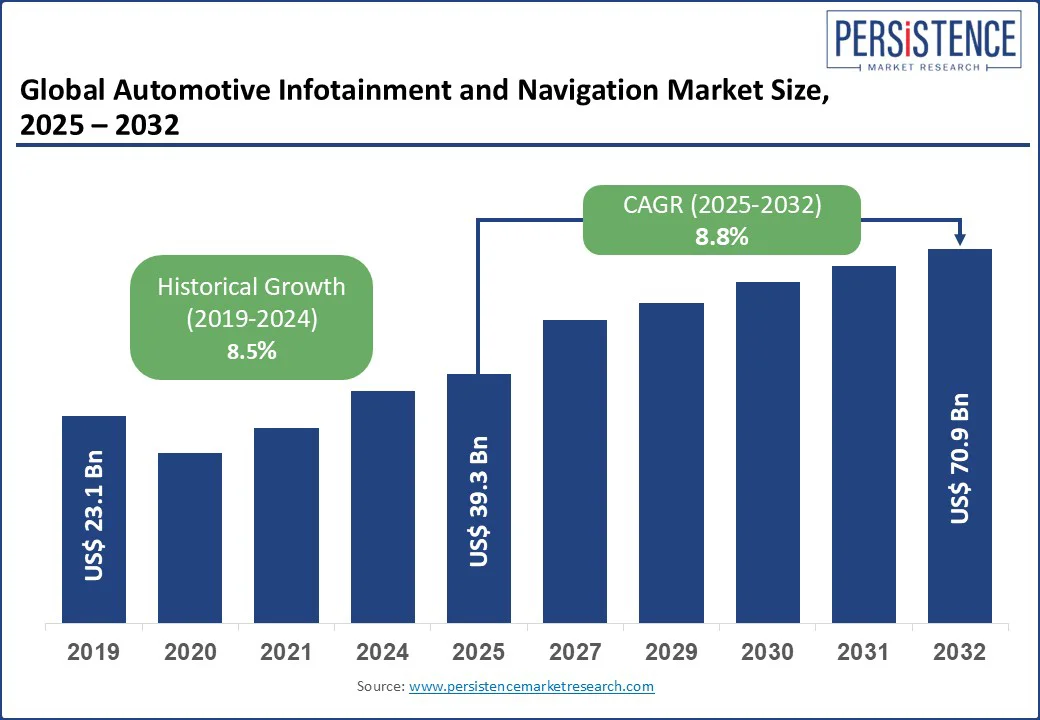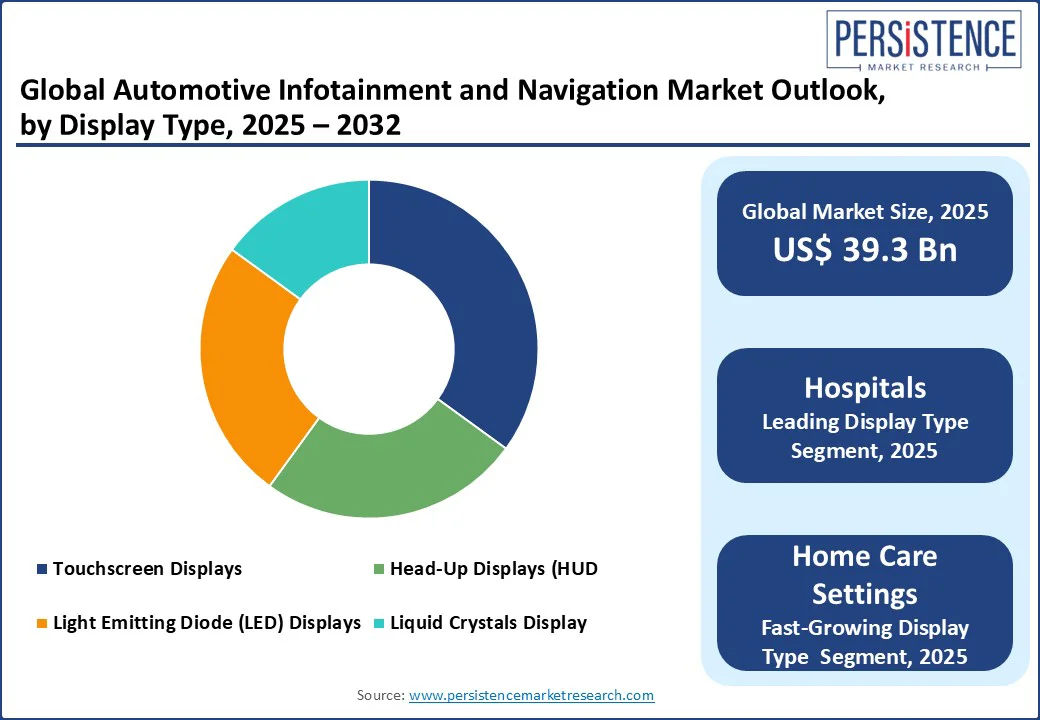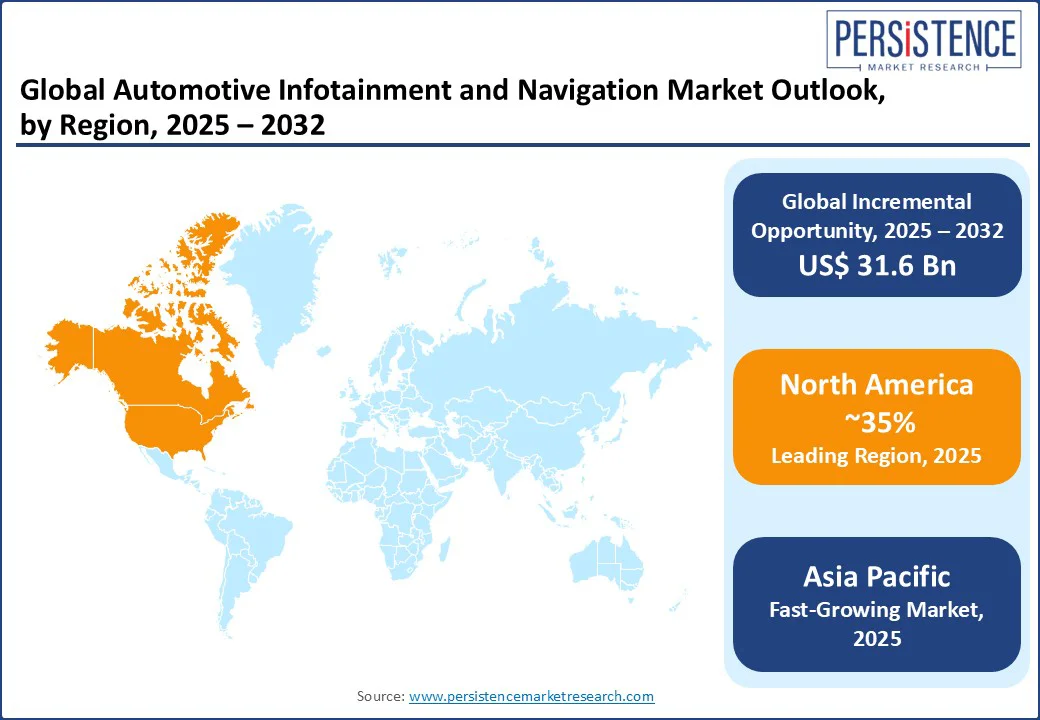ID: PMRREP4715| 165 Pages | 26 Aug 2025 | Format: PDF, Excel, PPT* | Automotive & Transportation

The global automotive infotainment and navigation market size is set for significant growth, with a projected market size of US$ 39.3 Bn in 2025, expected to reach US$70.9 Bn by 2032, at a robust CAGR of 8.8% during the forecast period 2025-2032
The automotive infotainment and navigation market is experiencing significant growth, driven by the rising demand for connected vehicles, advanced driver assistance systems (ADAS), and personalized in-car experiences. Modern cars are increasingly equipped with touchscreen displays, voice control, smartphone integration, and cloud-based services, transforming the driving experience into a digitally connected ecosystem.
Key Industry Highlights:

|
Global Market Attribute |
Key Insights |
|
Automotive Infotainment and Navigation Market Size (2025E) |
US$39.3 Bn |
|
Market Value Forecast (2032F) |
US$70.9 Bn |
|
Projected Growth (CAGR 2025 to 2032) |
8.8% |
|
Historical Market Growth (CAGR 2019 to 2024) |
8.5% |
The automotive infotainment and navigation market is driven by the growing demand for connected and autonomous vehicles, which in turn boosts the adoption of in-vehicle infotainment, automotive GPS, and smart car infotainment. Globally, 30% of new vehicles in 2025 featured advanced driver-assistance systems (ADAS) requiring telematics systems, driving the need for voice-controlled car infotainment systems and cloud-based automotive navigation platforms.
Touchscreen infotainment for vehicles and digital dashboards enhance user experience, while GPS navigation devices and real-time traffic navigation systems support autonomous driving. Connected vehicle platforms with human-machine interface (HMI) in vehicles ensure seamless integration with automotive connectivity solutions, such as Vehicle-to-Everything (V2X) Communication.
The rise in OEM infotainment systems and navigation software aligns with consumer expectations for enhanced safety and connectivity, driving demand for car infotainment consoles and vehicle navigation technology in modern vehicles.
The automotive infotainment and navigation market faces a significant restraint due to high development and integration costs, impacting the adoption of telematics systems and automotive smart infotainment. Developing advanced connected vehicle platforms and cloud-based automotive navigation platforms incurs costs exceeding US$500 Mn annually for major manufacturers, limiting scalability for smaller players.
The complexity of integrating human-machine interface (HMI) in vehicles, real-time traffic navigation systems, and vehicle navigation technology with existing vehicle architectures increases production costs, hindering the affordability of OEM infotainment systems and digital dashboards, particularly in price-sensitive markets.
Advancements in automotive connectivity solutions, particularly Cellular Networks (4G/5G) and Vehicle-to-Everything (V2X) Communication, present a significant opportunity for the Automotive Infotainment and Navigation Market. With 40% global adoption of 5G-enabled vehicles projected by 2025, there is growing demand for connected vehicle platforms and real-time traffic navigation systems.
These technologies enhance in-vehicle infotainment, voice-controlled car infotainment systems, and cloud-based automotive navigation platforms, supporting seamless data transfer and improved navigation accuracy. The rise in smart car infotainment and telematics systems aligns with global automotive technology trends, positioning the market for growth in connected and autonomous vehicle applications.
Integrated Infotainment Systems hold a 45% market share in 2025, driven by their seamless integration with in-vehicle infotainment and automotive GPS. With 50% adoption in passenger cars, these systems are favored for their car infotainment console and touchscreen infotainment, offering a unified user experience with navigation software. Their compatibility with Apple CarPlay, Android Auto, and cloud-based services enhances convenience and personalization, which consumers highly value
Embedded systems are fueled by demand for smart car infotainment in autonomous vehicles. With 12% growth in 2025, these systems support vehicle navigation technology and digital dashboards, driven by advancements in OEM infotainment systems. The increasing adoption of 5G connectivity, edge computing, and AI-driven analytics has further accelerated their relevance, enabling low-latency responses and over-the-air updates.
GNSS commands a 50% market share in 2025, driven by its widespread use in automotive GPS and GPS navigation devices. With 55% adoption in 2025, GNSS supports real-time traffic navigation systems and cloud-based automotive navigation platforms for precise location tracking. With growing demand for integrated navigation in infotainment consoles and dependence on satellite-based navigation for rural and urban areas, GNSS remains the backbone of in-vehicle navigation systems.
Sensor fusion is fueled by its role in autonomous driving. With 11% growth in 2025, this technology integrates vehicle navigation technology with telematics systems, enhancing connected vehicle platforms. This capability is essential for autonomous driving, ADAS (Advanced Driver Assistance Systems), and next-generation connected vehicles, where safety and precision are non-negotiable.
Touchscreen displays hold a 55% market share in 2025, driven by touchscreen infotainment for vehicles and car infotainment consoles. With 60% adoption in 2025, these displays enhance human-machine interface (HMI) in vehicles and digital dashboards. They are widely adopted across passenger cars and premium vehicles, driven by the popularity of integrated infotainment systems that consolidate music, navigation, and communication into a single screen.
Head-Up Displays (HUD) fueled by demand for safety-focused vehicle navigation technology. With 10% growth in 2025, HUDs are adopted in luxury vehicles for real-time traffic navigation systems. The rapid growth of advanced driver assistance systems (ADAS), connected cars, and autonomous vehicle technologies is accelerating HUD adoption, as these systems require seamless and real-time information delivery.
Bluetooth holds a 40% market share in 2025, driven by its widespread use in in-vehicle infotainment. With 45% adoption in 2025, Bluetooth supports voice-controlled car infotainment systems and connected vehicle platforms. Bluetooth technology is widely adopted due to its low power consumption, reliability, and ability to connect multiple devices simultaneously, making it ideal for infotainment systems.
Cellular networks (4G/5G) fueled by automotive connectivity solutions. With 15% growth in 2025, 5G enables cloud-based automotive navigation platforms and real-time traffic navigation systems. The rollout of 4G LTE and 5G networks has accelerated adoption, as these technologies provide low delays, ultra-fast speed, and high bandwidth, which enabling advanced features such as vehicle-to-some (V2X) communication, distant diagnosis, and increased security systems.
Passenger Cars hold a 50% market share in 2025, driven by high vehicle ownership and demand for smart car infotainment. With 55% adoption in 2025, this segment relies on OEM infotainment systems and digital dashboards. The rise of connected vehicles, electric cars, and premium variants in mass-market segments has further boosted the adoption of sophisticated infotainment solutions.
Features such as voice assistants, real-time traffic updates, wireless charging, and OTA (Over-the-Air) updates are now becoming standard in mid-range and luxury passenger cars.
Electric vehicles are fueled by adoption. With 12% growth in 2025, this segment drives demand for telematics systems and cloud-based automotive navigation platforms. Dissimilar to conventional cars, EVs heavily rely on digital ecosystems for battery monitoring, energy optimization, route planning with charging station locators, and real-time software updates, making infotainment a critical component.

North America holds a 35% global market share in 2025, with the U.S. leading due to its advanced automotive industry, generating US$ 13.76 Bn in sales in 2025. The U.S. market growth is recorded at a CAGR of 8.6%, driven by demand for in-vehicle infotainment and automotive GPS, with 70% of passenger cars using touchscreen infotainment for vehicles in 2025.
Key drivers include a 25% increase in connected vehicle sales, boosting connected vehicle platforms and real-time traffic navigation systems. Harman International and Garmin Ltd. drive 25% of regional revenue, with voice-controlled car infotainment systems seeing 10% growth. The focus on autonomous driving fuels telematics systems and digital dashboards.
Europe accounts for a 30% global share, led by Germany, the UK, and France. Germany’s market grows at a CAGR of 8.5%, driven by its automotive manufacturing hub, with 60% of vehicles using OEM infotainment systems in 2025. The UK’s market is propelled by cloud-based automotive navigation platforms, with retail chains such as BMW adopting digital dashboards.
France sees 12% growth in vehicle navigation technology, driven by demand for human-machine interface (HMI) in vehicles. EU investments, with €200 Mn in connected vehicle technologies in 2025, boost automotive connectivity solutions. Continental AG holds a 10% market share, leveraging real-time traffic navigation systems.
Asia Pacific is the fastest-growing region, with a CAGR of 9.3%, led by China, Japan, and India. China holds a 45% regional market share, driven by a 20% increase in vehicle production in 2025, boosting in-vehicle infotainment and automotive GPS.
India’s market is fueled by rising vehicle ownership, with 75% of urban vehicles using touchscreen infotainment for vehicles in 2025. Japan’s telematics systems drive 10% growth in connected vehicle platforms, supported by its advanced automotive sector. Denso Corporation and Panasonic Corporation lead, supported by US$ 5 Bn in automotive tech investments by 2030, enhancing smart car infotainment.

The global automotive infotainment and navigation market is highly competitive, with automotive technology companies focusing on innovation, connectivity, and user experience. Robert Bosch GmbH and Continental AG lead in OEM infotainment systems, while Harman International excels in voice-controlled car infotainment systems.
Telematics systems, connected vehicle platforms, and real-time traffic navigation systems drive competition. Strategic partnerships and R&D investments in automotive smart infotainment and cloud-based automotive navigation platforms are key differentiators, addressing consumer and autonomous driving needs.
The automotive infotainment and navigation market is projected to reach US$ 39.3 Bn in 2025, driven by in-vehicle infotainment and automotive GPS.
The demand for connected vehicles, with 30% of new vehicles featuring ADAS in 2025, drives smart car infotainment.
The automotive infotainment and navigation market grows at a CAGR of 8.8% from 2025 to 2032, reaching US$ 70.9 Bn by 2032.
Cellular Networks (4G/5G), with 40% adoption in 2025, offer opportunities for connected vehicle platforms.
Key players include Robert Bosch GmbH, Continental AG, Harman International, and Garmin Ltd.
|
Report Attribute |
Details |
|
Historical Data/Actuals |
2019 - 2024 |
|
Forecast Period |
2025 - 2032 |
|
Market Analysis Units |
Value: US$ Bn, Volume: As Applicable |
|
Geographical Coverage |
|
|
Segmental Coverage |
|
|
Competitive Analysis |
|
|
Report Highlights |
|
|
Customization and Pricing |
Available upon request |
By Product Type
By Technology
By Display Type
By Connectivity
By End-use
Delivery Timelines
For more information on this report and its delivery timelines please get in touch with our sales team.
About Author